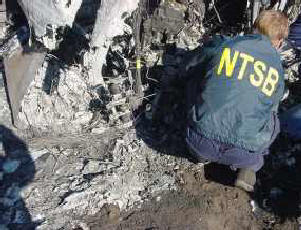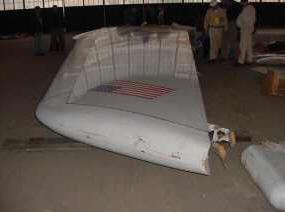
 |
| American Airlines Flight 587 Bound For Dominica Crashes In Belle Harbor, New York |
| An Emergency Airworthiness Directive (AD) Has Been Issued Which Calls For A Visual Inspection. |
| Was Flight 587 Shot Down By A Surface To Air Missile And Is There A Federal Cover Up ? |
|
November 12, 2001, The National Transportation Safety Board dispatched a full Go Team on Monday, November 12, to the site of the crash that day of American Airlines flight 587, an Airbus A-300, N14053, which had just taken off from Kennedy International Airport in New York for the Dominican Republic. The airliner crashed into a neighborhood in Belle Harbor, New York. The engines and some tail components were found some distance from the main wreckage site. Both the Cockpit Voice Recorder (CVR) and Flight Data Recorder (FDR) were recovered. The Safety Board dispatched approximately 40 personnel to the scene. The team is working under the direction of Investigator. In Charge Robert Benzon. Chairman Marion Blakey and Member George Black accompanied the team. Among the investigative groups that comprise the NTSB team are Operations, Witnesses, Structures, Power Plants, Systems, Air Traffic Control, Weather, Aircraft Performance, Cockpit Voice Recorder and Flight Data Recorder. |
 |
 |
Parties to the investigation are the Federal Aviation Administration, American Airlines, General Electric Engines, Allied Pilots Association, the National Air Traffic Controllers Association, and the Association of Flight Attendants. In addition, as the aircraft was manufactured in France, the Safety Board's counterpart agency, the Bureau Enquêtes Accidents, is the Accredited Representative to the investigation under the rules of the International Civil Aviation Organization. Airbus Industries is an advisor to the BEA. Accident Sequence: Investigators have continued to extract data from the flight recorders - the flight data recorder (FDR) and the cockpit voice recorder (CVR) - since their recovery last week, as well as radar data. The Safety Board has calculated that the time between flight 587’s liftoff from Runway 31L until the end of the recorded FDR data is 93 seconds. The CVR continued to record information for about 10 more seconds (this is a correction of the time announced last week); it is believed the CVR ends at or about the time of the plane’s impact with the ground. Therefore, the Board estimates that the time from lift off to impact was 103 seconds. |
|
|
Based on radar data, flight 587 took off approximately 105 seconds behind Japan Airlines flight 47, a Boeing 747. The FDR indicates that flight 587 encountered two wake vortices generated by JAL flight 47. The second wake encounter occurs about 8 seconds before the end of the FDR data. For the first few seconds after the second wake encounter, the aircraft responded to flight control inputs. Both wake encounters averaged about 0.1 G lateral (side to side) movement. During the last 8 seconds of FDR data, the plane experienced three stronger lateral movements, two to the right of 0.3 and 0.4 Gs, and then one to the left of 0.3 Gs. These lateral forces corresponded in time with rudder movements. Aircraft Structures: The wreckage from flight 587 has been moved to a temporary storage facility at Floyd Bennett Field. Visual examination of the tail fin and rudder assemblies was conducted in a hangar there. Arrangements are being made to transfer portions of those components to another facility for more detailed examination. |
|
|
|
While at the scene, the Safety Board reported that a jack screw associated with the rudder trim system found in the wreckage showed a 10 degree left trim setting. Further examination of that jack screw, along with readings off the flight data recorder, show that the trim setting appears to be close to neutral. The aircraft’s wing flaps appear to have been retracted at the time of impact, and the landing gear appear to have been stowed, based on both physical evidence and FDR readings. Engines: Both engines were examined at the crash site and at a hangar at Kennedy Airport. No evidence was found of an uncontained engine failure, loss of blades, bird strike or in-flight fire. The thrust reversers were in the stowed position. The engines will be taken to the American Airlines maintenance facility in Tulsa, Oklahoma for a detailed tear-down in a few weeks. |
||
| ŠAvStop Online Magazine Contact Us Return To News | ||